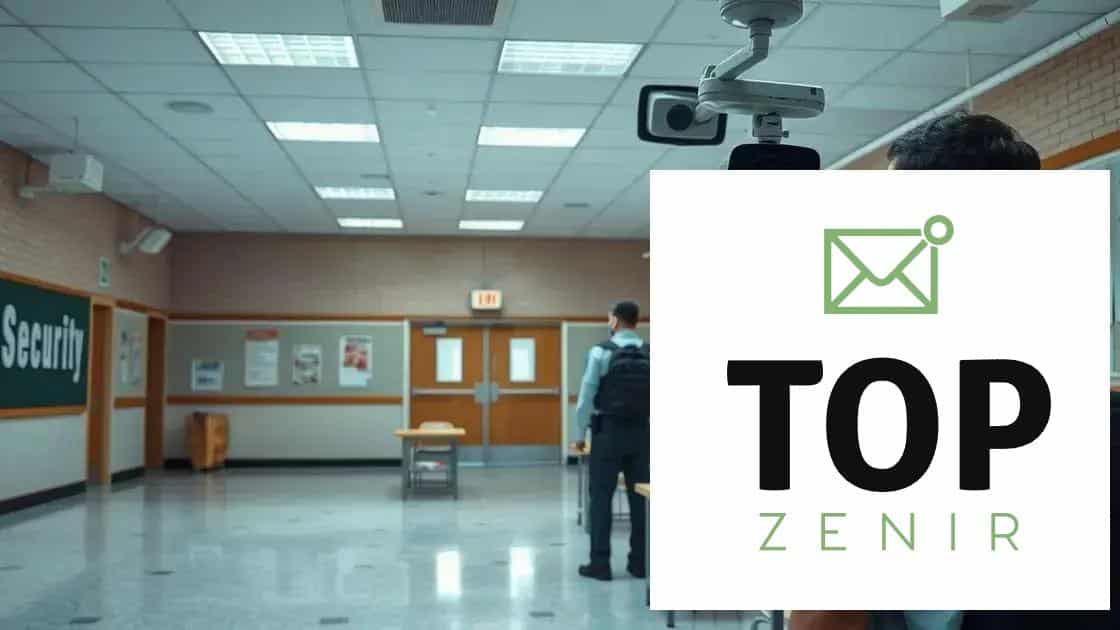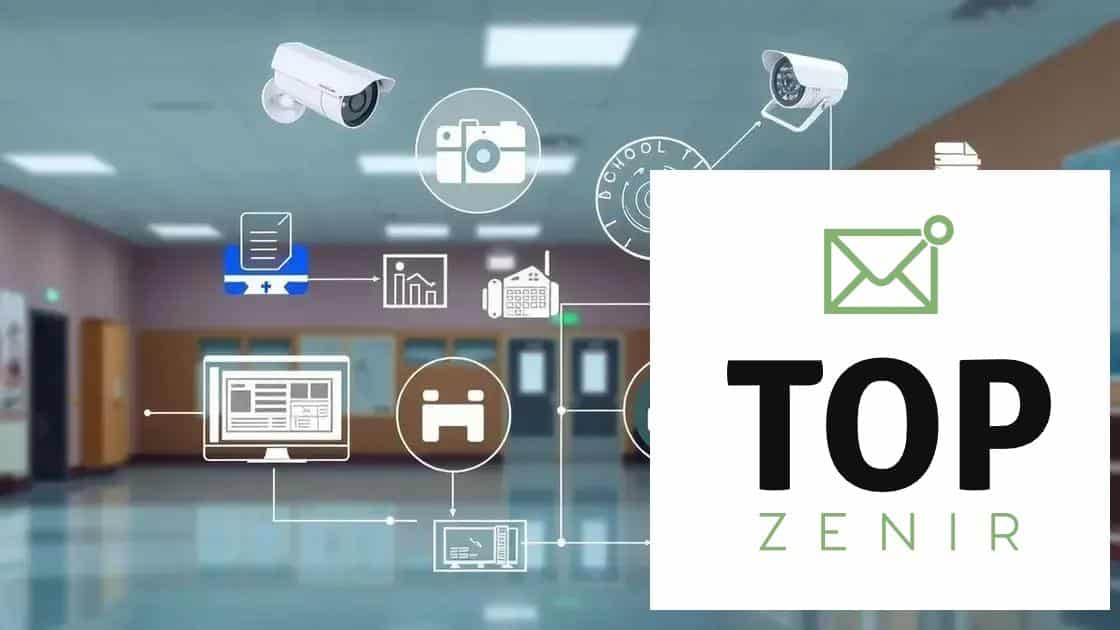National policies to improve school security: A closer look

National policies to improve school security involve community engagement, effective technology integration, and tailored safety protocols that collectively enhance student and staff safety within educational environments.
National policies to improve school security are increasingly crucial in today’s educational landscape. With rising concerns about student safety, exploring effective strategies can make a real difference. What measures can be put in place to protect our schools?
Understanding the need for improved school security
In today’s world, understanding the need for improved school security is essential for parents, educators, and policymakers alike. Schools should be safe havens for learning, but recent events have highlighted vulnerabilities that must be addressed.
The Importance of School Security
Effective school security measures help create a secure environment for students and staff. When schools prioritize safety, they are not only protecting individuals but also fostering a sense of community and trust.
- Decrease in violence and bullying incidents
- Enhanced learning environment
- Positive impact on student mental health
Furthermore, the community’s involvement plays a pivotal role in enhancing school security. Engaging parents and local organizations can provide valuable insights and resources, making safety initiatives more effective.
Recognizing Potential Threats
Understanding potential threats is a key component of building an effective security policy. These threats can vary from natural disasters to security breaches. By identifying vulnerabilities, schools can implement appropriate measures.
- Conducting regular safety assessments
- Training staff on emergency response
- Establishing clear communication protocols
The proactive approach to school security not only protects students but also prepares them for the unexpected. Schools can empower students by involving them in safety discussions and encouraging them to report concerns.
Key components of effective national policies
Understanding the key components of effective national policies is crucial for improving school security. These components lay the foundation for comprehensive and actionable security measures that benefit students and staff alike.
Legislation and Guidelines
One of the primary components is the establishment of clear legislation and guidelines. These policies set the standards that schools must follow to ensure a safe environment. Well-defined rules can significantly reduce ambiguity and guide schools in implementing necessary measures.
- Creating robust safety regulations
- Defining roles and responsibilities
- Ensuring compliance through audits
Moreover, training and resources for school staff play a significant role in the success of these policies. Providing ongoing education ensures that educators know how to respond during emergencies.
Collaboration with Local Authorities
Another essential aspect is collaboration with local law enforcement and emergency services. Establishing strong relationships helps schools prepare for various situations, from medical emergencies to security threats. Regular drills and meetings can enhance this relationship, leading to faster response times in case of an incident.
- Regular safety drills and simulations
- Sharing resources and information
- Formulating emergency response plans together
Inclusive policies also take into account the input from parents and the community. Engaging stakeholders helps ensure that policies are relevant and address the actual needs of the school environment. This collaborative approach fosters trust and transparency, making everyone feel more secure.
Ultimately, the integration of technology into these policies is essential. Using tech solutions like surveillance systems and communication apps enhances real-time monitoring and reporting. Emphasizing data security also ensures that sensitive information regarding students and staff remains protected.
Case studies: Successful implementations in various countries
Examining case studies of successful implementations helps us understand how national policies to improve school security can be effectively applied in real-world settings. Different countries have designed unique approaches, each offering valuable lessons.
United States: Comprehensive Safety Plans
The United States has pioneered various safety plans that involve multiple stakeholders. Schools often collaborate with local law enforcement and community organizations to create tailored safety protocols. These plans frequently include:
- Regular training sessions for staff and students.
- Drills for emergency scenarios, improving readiness.
- Implementation of anonymous reporting systems for students.
Such measures have led to a decrease in incidents of violence and a more secure learning environment.
Japan: Integrated Community Systems
In Japan, school security is often linked with community engagement. Schools work closely with local neighborhoods, involving parents and citizens in safety programs. This collaboration brings community members into the fold, enhancing vigilance around school premises.
- Neighborhood watch programs near schools.
- Frequent safety workshops for students and parents.
- Utilizing community resources for emergency responses.
This model creates a strong safety net that decreases risks and fosters community spirit.
Finland: Focus on Environmental Design
Finland emphasizes the role of environmental design in school security. Schools are built and maintained with safety in mind, using layouts that minimize risks and encourage visibility. Features include:
- Open spaces for monitoring areas.
- Controlled access points to limit entry.
- Green spaces that enhance mental well-being.
These elements not only improve security but also create a welcoming atmosphere for students.
By learning from these varied implementations, other countries can adapt successful strategies to enhance their own school security policies. Each of these case studies reveals unique insights into fostering a safe educational environment through collaboration, design, and community involvement.
The role of technology in enhancing security measures

The role of technology in enhancing security measures has become increasingly vital in schools around the globe. Technology provides tools that not only improve safety but also streamline communication during emergencies.
Surveillance Systems
One of the most visible uses of technology is through surveillance systems. These systems can monitor school premises in real-time, providing a sense of security for students and staff. With advanced features, such as:
- High-resolution cameras for clearer images.
- Nigh-vision capabilities for 24/7 monitoring.
- Remote access for security personnel to view footage live.
This technology helps to deter criminal activity while also aiding in incident investigations.
Communication Tools
In addition, modern communication tools are essential. Schools today have access to various apps that facilitate quick communication in emergencies. Features can include:
- Instant messaging capabilities for staff and students.
- Alerts and notifications sent directly to parents.
- Emergency contact lists for quick outreach during a crisis.
These tools enhance the ability to respond effectively in critical situations, ensuring that everyone stays informed.
Furthermore, technology also extends to access control systems. This includes electronic keycards and biometric scanners. Such measures restrict entry to authorized individuals only, enhancing physical security. Additionally, data analytics can help identify patterns that may indicate safety threats, allowing schools to take proactive measures.
Community involvement in shaping school security policies
Community involvement plays a crucial role in shaping school security policies. When schools engage with parents, local organizations, and law enforcement, they create a comprehensive approach to safety that reflects the unique needs of their environment.
Building Trust and Communication
Effective communication is key to fostering community involvement. Schools can hold forums and meetings to discuss safety concerns and gather input. By inviting feedback, they can:
- Understand the specific needs of the community.
- Encourage parents to report any safety issues.
- Build a trustful relationship between families and the school.
This open line of communication ensures everyone feels valued and heard.
Training and Resources
Additionally, community involvement can include training programs. Schools can collaborate with local law enforcement to offer educational workshops for both students and parents. These programs may cover:
- Emergency preparedness and response techniques.
- Conflict resolution strategies for students.
- Resources available for mental health support.
Such initiatives empower families and equip them to contribute positively to school safety.
Moreover, community organizations can provide resources and support that enhance security measures. Partnerships with local businesses may yield donations or volunteer services to improve facilities and practices, ensuring an investment in the security of local schools.
By fostering a collaborative environment among schools and the community, the effectiveness of school security policies is significantly strengthened. This partnership not only enhances safety but also enriches the educational experience for students.
In conclusion, improving school security requires a multi-faceted approach that includes community involvement, effective policies, and the integration of technology. By working together, schools, parents, and local organizations can create safer learning environments for all students. Collaboration along with proactive measures ensures a well-rounded strategy that enhances safety and builds trust within the community. Adopting best practices from successful case studies around the globe can also lead to impactful changes in our educational settings.
FAQ – Frequently Asked Questions about School Security Policies
Why is community involvement important in school security?
Community involvement helps schools gather valuable feedback, leading to better safety practices and stronger relationships between families and school officials.
What are some effective technology tools for enhancing school security?
Effective tools include surveillance cameras, communication apps for emergencies, and access control systems that restrict entry to authorized persons only.
How can training programs help improve safety in schools?
Training programs empower students, staff, and parents to respond effectively during emergencies, creating a more prepared and aware community.
What can schools learn from successful case studies in other countries?
Schools can adopt best practices from successful implementations worldwide, tailored to their unique environments, ensuring more effective security measures.





